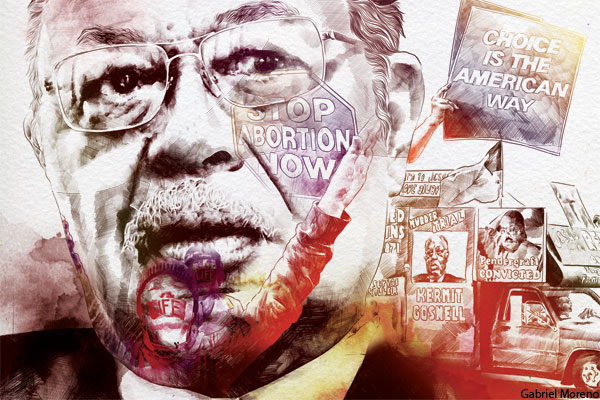Kermit Gosnell’s Babies
Part I: The Monster Smiles
The phone rang near 8:30 one night, and an automated message played: “You have a call from a federal inmate,” and then, patched in, his voice, high and a little singsong, the name “Kermit Gosnell.”
We had only briefly exchanged hellos, our first words to each other, when he made a request.
“I wonder,” he said, “could you send me a picture of yourself?”
“A picture?” I asked.
“They won’t let you send a Polaroid,” he said, “but if you can send some image of yourself, I just feel it would help me get to know you.”
I’ve spoken to many prison inmates in my career, but none of them ever asked for a photo. Gosnell, sensing my hesitation, said, “It’s really just to be able to see who I’m going to be talking to. I want to be very open and answer all your questions, and if we’re not going to see each other in person for an interview, this will help me to do that. If you could send something out in the next day or two, it will help me feel comfortable enough to talk.”
By the time of the phone call, Kermit Gosnell was a familiar figure to me. Last spring, I sat in a Philadelphia courtroom for his eight-week trial, watching as he was ultimately convicted of first-degree murder in the deaths of three babies; one involuntary manslaughter count; and more than 200 counts of violating Pennsylvania’s Abortion Control Act. Following the trial, Gosnell and I began exchanging letters. Eventually I was placed on his phone list—the only journalist he’s spoken with since his trial.
Over the ensuing weeks I received 12 letters from Kermit Gosnell, more than 50 emails, and more than two dozen phone calls. (The Federal Bureau of Prisons denied my visitation requests.) I learned much about his life, how he feels after losing his case, and how he came to be standing over multiple babies with surgical scissors in his hand.
As a narrator of his own life, Gosnell is both open and confounding, honest and unreliable. His manner is relaxed and even breezy, his tone more like that of a man with no serious cares than one incarcerated for life, his name now looming alongside the most infamous murderers in this city’s history. “I am committed to proving my innocence,” Gosnell wrote in an email to me, “no matter how long it takes.”
But Gosnell never sounded like other inmates I’d interviewed over the years. At one point, I remarked upon this to him—about his lack of anger, bitterness and desperation. “No, I’m not bitter,” he said. “I hold no ill will toward the district attorney, the witnesses and my former colleagues, or even the prosecutors. I think about George Tiller, who was assassinated in his church, and I am appreciative that I did not meet the same fate.”
Gosnell invokes the name of George Tiller often. The Kansas-based abortion provider was murdered in 2009 by a pro-life gunman. But in conversation Gosnell proved elliptical—the nature of his connection to Tiller, if any, unfolding as we talked, the reasons for which he believes himself innocent emerging slowly.
“I hope you don’t find my answers to your questions overlong,” he warned me in that first conversation. “But there is a lot of background you will need to understand. This will take some time.”
>>To read the full, expanded version of this story — including details about babies born alive inside Gosnell’s West Philly abortion clinic, the doctor’s hoarding tendencies, and why exactly he doesn’t see himself as a criminal, plus much more not available in the print edition of Philadelphia magazine — buy the e-book, Gosnell’s Babies, available now for Kindle, iPad/iPhone, Android, Windows and Mac exclusively on Amazon.
Watch Philadelphia magazine editor Tom McGrath and Steve Volk take questions about Gosnell’s Babies below:



